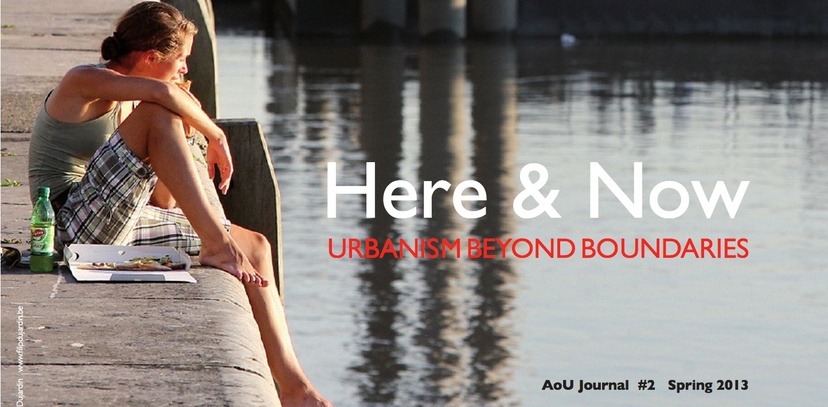
This article was first published in the Academy of Urbanism Journal No 2 - Here and Now Urbanism Beyond Boundaries (Spring 2013)
Le Corbusier on Quartier Modernes Fruges at Pessac [1]
It might seem like a cliché to begin a discussion about the boundaries of urbanism with a quote from Le Corbusier, but this well-known statement sums up concisely the tension that exists between the two dimensions of urbanism, defined on one hand, as the characteristics of urban social life and city dwelling, and on the other, the physical processes of planning and development. The architecture critic Ada Louise Huxtable, writing in the 1980s about Le Corbusier's experimental community at Pessac, recognized in this quote that Le Corbusier was not confessing his project to be a failure because the occupants had chosen to adapt (in some cases quite significantly) the architecture and spatial plan.[2] Rather, he was acknowledging the messiness of everyday life, the complexity of human interaction with the built environment, and the inevitable, incremental adaptation and appropriation of spaces and plans that are not imagined by the architect or planner.
As a professional practice and field of policy, urbanism is dominated by the physical: architecture, planning, development, regeneration, housing, infrastructure. The social life of cities and in particular, the ordinary, the everyday, the mundane aspects of urban life are frequently overlooked in the rush to create and regenerate at scale or to a pre-defined set of principles - Garden Cities, New Urbanism, Compact Cities, Modernism, Smart Cities, Eco-Towns, Sustainable Urbanism - each generating their own assumptions and limits about how people will live and work within their boundaries.
Past experience shows that people need scope to shape and adapt the environment around them. From Pessac to Pruitt-Igoe and many more, less visionary examples in between, the experience has been that reality takes hold and life diverges from the plan. At one extreme, open spaces are reimagined: benches become skateparks, bus shelters temporary housing, The Shard becomes a destination for romantic liaisons. At the other end, visionary plans stumble or fail but not always in the same way or for the same reasons: people struggle to manage the technology in their eco-homes so abandon the cause, gleaming Smart Cities fail to attract new residents and workers, some new towns struggle and others flourish.
Intuitively we know what makes one place different from another. Yet this difference is hard to articulate and even harder to translate into the planning and design process. Arguably, the answer is not in a particular model of urbanism but in finding a way to reconcile the physical and social, grand vision and local reality, in order to plan, design, develop and manage places in a way that is attuned to local circumstances.
Harvey Molotch's work on place difference provides a framework for thinking holistically about local context. He traces the development trajectory of Ventura and Santa Barbara, two neighbouring California counties with similar socio-demographics and similar opportunities. Both experienced oil development, freeway projects, and housing growth at the same time, yet the specific local circumstances - politics, social networks, community organisations, local history, culture and global connections - created very different, measurable outcomes in terms of employment, wealth and future infrastructure. Molotch stresses the importance of understanding 'connective tissue' - the multiple connections between people, organisations, ideas, opportunities, cities and neighbourhoods, that 'lash up' in different ways to create processes and outcomes that are specific to times and places.[3]
If we know that similar places with similar opportunities develop in dramatically different ways, what does this mean in practice? As practitioners, we need an understanding of what places mean to people and how they can shape quality of life, wellbeing and opportunities. We also need to understand the multiple connections and interactions people have with the built environment without getting caught up in the trap that 'place' automatically means a bounded community and consensus.
Molotch's work on place difference is one way to think about circumventing the artificial boundaries between social, physical, environmental and economic that are become encoded and taken for granted in planning, policymaking and development. Dan Lockton's fascinating blog Architectures proposes another approach. Lockton examines Stewart Brand's concept of 'High Road' and 'Low Road' architecture. 'Low Road' architecture is designed for adaptation, to allow users to make changes as their needs evolve, while 'High Road' architecture is designed specifically to shape the behaviour of future users. Lockton proposes a 'Low Road read/write urbanism' that creates space for adaptation as patterns of social behaviour emerge.[4] His proposal is more subtle than the top-down versus bottom-up discussion which debates often default to when the question of user involvement or local circumstances are raised. Both Lockton and Molotch's approaches seem to argue for a shift from fixed models to fluid, locally specific understandings that can combine plans, strategies and control with insights about everyday life that will hopefully, lead to the creation of places that work better for people.
Resources are scarce so there is little scope for making mistakes with the current generation of housing and infrastructure projects, and tough decisions have to be made. However, this kind of pressure also opens up spaces and opportunities for innovation and change. Can we use this opportunity to think about urbanism that goes beyond community involvement in planning and design to become genuinely informed by the everyday social experience?
This article was written by saffron.woodcraft@social-life.co
[1] Boudon, P.,1972. Lived-in architecture : Le Corbusier's Pessac revisited, London: Lund Humphries.
[2]LE CORBUSIER'S HOUSING PROJECT- FLEXIBLE ENOUGH TO ENDURE (1981). New York Times
[3] Molotch, H., Freudenburg, W. & Paulsen, K.E., 2000. History Repeats Itself, But How? City Character, Urban Tradition, and the Accomplishment of Place. American Sociological Review, 65(6), pp.791-823.
[4] Lockton, D. Architecture, urbanism, design and behaviour: a brief review http://architectures.danlockton.co.uk/